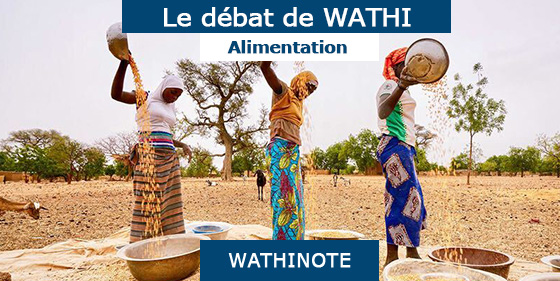

Author: Mariano J. Beillard
Site of publication: USDA – Foreign Agricultural Service (FAS-USDA)
Type of publication: Report
Date of publication: May 6, 2019
The wheat planting campaign commences in the fall, with the harvest occurring normally in April. Wheat production lands during the rainy season (late April-September) are under cultivation with rainfed crops. Rice is sometimes double-cropped with wheat. Both wheat and rain-fed crop farmers are dependent on timing of when rains commence and end. Farmers for over a decade now have been struggling to predict when rains will come; this is adversely affecting farming operations. Flooding during July to October 2018, ravaged farms nationwide undermining Nigeria’s food security.
Sources indicate that some agribusinesses are increasing their number of contracted wheat farmers. With the aim of boosting yields and quality, agribusinesses are extending training to their contract wheat farmers. The incentive is leading to some production increases. Nigeria’s traditional wheat producing regions are located in the country’s northeast region and in the highlands. Wheat production in the northeast region has been declining in recent years due to Islamist insurgencies. Sources comment that for production levels to increase, in order to come close to meeting local demand needs, this will require long-term private sector investment along with massive infrastructure development and greater access to untitled (free) lands.
Farmers for over a decade now have been struggling to predict when rains will come; this is adversely affecting farming operations. Flooding during July to October 2018, ravaged farms nationwide undermining Nigeria’s food security.
Domestic Wheat Purchase Incentives, Not Working: Flour millers favor imports, indicating that locally produced wheat tends to have higher protein content, lower moisture and lower gluten; citing characteristics not well suited for bread production. Notwithstanding Nigerian millers’ preference for imported wheat, the government (commencing in 2017) is aiming to reduce wheat imports by 50 percent. To reduce imports, the government is requiring millers to purchase local wheat at a fixed price of $400 per metric ton.
The Central Bank of Nigeria (CBN) effectively devalued the Nigerian naira (NGN) in February 2017, when it authorized private individuals to buy U.S. dollars at almost 20 percent above the normal rate for travel, some school fees and medical bills. This sly devaluation resulted in driving up the price of locally produced wheat to $420 per metric ton.
The Nigerian government, along with humanitarian relief organizations, and non-governmental organizations (NGO) routinely purchase local wheat at roughly $500/MT, paying a $100/MT premium. This wheat goes to Nigerians (living in camps) displaced by the Boko Haram insurgency. Wheat farmers are refusing to sell at the mandated $400/MT rate to millers, preferring to sell to the institutional buyers and or export at premium rates.
Consumption
FAS Lagos forecasts Nigeria’s wheat consumption in MY 2019/20 at 5.26 million metric tons (MT), up nearly four percent or 200,000 MT higher than from Post’s MY 2018/19 estimate of 5.06 million metric tons. Post is revising upwards the U.S. Department of Agriculture (USDA) official MY 2018/19 estimate by 200,000 MT, attributing the increase to an uptick in imports combined with an increase in food, seed and industrial (FSI) usage. The rise in FSI wheat consumption is attributable to population growth of about 2.54 percent (2015-20).
More than half of Nigeria’s population (estimated at 203.4 million -July 2018) live in urban areas (urbanization is growing at a rate of 4.23 percent annually). The country has largest population of any African nation. Significant population clusters are scattered throughout the country, with the highest density areas in the south and southwest. The population, projected to grow to 392 million by 2050, will make Nigeria the world’s fourth most populous country. This population is increasingly reliant on domestic and imported processed food products. Bread, semolina, and durum pastas and other wheat flour-based products are major stables in Nigeria’s urban areas.
Seventy percent of the flour milled from wheat goes into bread production; pasta and other wheat flourbased products (including semolina) account for the balance. Sources comment that wheat byproducts goes into animal feed. Russia, the United States, Canada, and Australia supply the bulk of Nigeria’s wheat imports destined for milling and product production. Sources indicate that the flour milled from local wheat is not economically suitable for the manufacture of bread, pasta, and noodles. Local wheat flour is however, nonetheless used in the preparation more traditional/customary meals in Nigeria and in the Sahel region.
Pasta Consumption: Nigerian pasta consumption is growing, accounting for about 15 percent of wheat flour usage, up from virtually zero in 1999. Flour Mills of Nigeria pioneered pasta production in 1999; since then it expanded pasta production capacity from 40,000 MT (1999) to 350,000 MT today. Dangote similarly expanded its own milling capacity from 15,000 MT/year in 2000 to a total installed capacity of 800 MT/day currently. Other major players in pasta production include Honeywell Flour Mill and OLAM/Crown Flour Mills. Expansion began in earnest in 2003 following the government imposing a 100 percent tariff on imported pasta and biscuits. In 2008, the government did lift this tariff as the local manufacturing industry took off.
Bread: Leventis Bakery, in partnership with FMN, is Nigeria’s sole surviving mass-scale bread producer. Leventis and FMN have installed new silos at their Lagos plant. Lagos state counts with more than 18,000 small- to medium-scaled independent bakery operations, retail in-store bakeries, and informal baker/entrepreneurs. Competition from these bakeries, combined with the high production costs has forced a number of automated bakery plants out of business. Bread demand in Nigeria remains elastic.
Policy: Nigeria imposes a five percent tariff on wheat imports, plus an additional 15 percent levy (earmarked for the national wheat development program) for a total 20 percent duty. The government’s policy on composite flour remains in place. The policy offers a 12 percent tax rebate to bakers willing to blend cassava flour with wheat flour for bread making. Industry sources however note that full enforcement of the composite flour policy is unlikely until flour millers, bakers, and other stakeholders, overcome technical challenges in developing an appropriate mix of wheat and cassava flours.
Wheat is not on the list of 41 items ineligible for foreign exchange access. However, the dollars required for wheat purchases are not always available, compelling Nigerian wheat traders to turn to the higher-rate parallel market instead of the Central Bank of Nigeria’s lower rate.
Nigeria continues to employ trade restrictive measures, including high tariffs, foreign exchange controls, levies and import bans to protect its domestic agricultural production (including grains), despite its membership in the World Trade Organization (WTO)
Nigeria’s Domestic Agriculture, Trade Policies and Implications: In 2018, a number of Nigeria’s state governments along with some large-scale private sector organizations successfully accessed the Nigerian government’s Anchor Borrower Program (ABP). The program provides farmers single-digit loans to boost domestic production. However, many rural/small holder farmers and cottage agribusinesses who produce over 80 percent of the country’s agricultural products indicate they remain cutoff from the program.
The modified Growth Enhancement Scheme (GES), an agricultural support program, initiated to assist farmers obtain inputs at subsidized costs has yet to be fully implemented. Due to limited funding availability, many farmers lack adequate inputs to increase their production. Access to fertilizer remains a challenge for small and medium-scale farmers, constraining efforts to increase grain production despite growing demand.
Nigeria continues to employ trade restrictive measures, including high tariffs, foreign exchange controls, levies and import bans to protect its domestic agricultural production (including grains), despite its membership in the World Trade Organization (WTO). Import trade data analyzed by Nigerian government agencies are usually, sourced from Nigeria Customs Service (NCS) and they are not truly reflective of the volume of imports, as NCS data does not account for contraband/smuggled products.
Consumption
Nigeria’s rice consumption in MY 2019/20 at 7.1 MMT, 100,000 MT lower than Post’s MY 2018/19 estimate of 7.2 million metric tons. Post attributes the projected decrease in consumption to higher prices coupled with weaker purchasing power—reducing rice per capita consumption to about 32 kilograms in MY 2019/20, down from an average 34 kilograms recorded over the past five years. Post expects however that the high cost of rough, paddy rice, as well as elevated operational costs will constrain Nigeria’s large-scale/integrated rice mills from producing at more competitive prices.
Trade: Nigeria’s rice imports in MY 2019/20 at 2.4 MMT, up nine percent or 200,000 MT higher than the MY 2018/19 estimate of 2.2 million metric tons. Imports largely comprise parboiled rice (also known as converted rice and easy-cook rice). Thailand- and India-origin rice (long-grain varieties) dominate imports. Though Thailand- and India-origin direct rice shipments to Nigeria have dropped off in recent years, there have been large, officially reported increases in rice exports to Nigeria’s neighbors Benin (population 11.3 million), Cameroun (population 25.6 million), Niger (population 19.8 million), and Togo (population 8.1 million). These are countries with lower import tariffs and porous borders.
Nigerians’ demand for foreign rice is strong despite the restrictions placed on the importation of rice. Sources estimate that overall, there are five bags of imported rice for every bag of local rice sold in the market. Nigerians’ preference for imported rice creates a market gap for nearly three million metric tons between rice demand and local supply.
Imported rice is also cheaper than locally produced rice, further driving consumer demand for foreign rice. A bag of imported rice (50 kilograms) averages Nigerian naira 13,500, while an equivalent size bag of clean, parboiled local rice retails for Nigerian naira 15,500. High internal transportation costs to the south of the country is one of the major constraints to locally produced rice.
Policy
Nigeria imposes a 10 percent tariff, plus a 60 percent levy (totaling 70 percent) on imported rice (arriving by sea). The official ban on rice imports through land borders remains, but is difficult to control. The Central Bank of Nigeria (Nigeria Federal Reserve equivalent) has introduced monetary measures that technically ban direct imports of rice into the country. The Nigerian government’s foreign exchange policy bars importers from using formal and informal sources of foreign exchange for rice imports. The measure aims to control the outflow of hard currency while promoting domestic production of 41 items.
Imported rice is also cheaper than locally produced rice, further driving consumer demand for foreign rice. A bag of imported rice (50 kilograms) averages Nigerian naira 13,500, while an equivalent size bag of clean, parboiled local rice retails for Nigerian naira 15,500
Food import bans are the cornerstone of the government’s agricultural development and food security agenda. High production costs, due to high input costs, low quality seeds, and inadequate infrastructure make domestic rice not price competitive. Private sector investors are keen to invest in rice production given support programs and protective trade policies.
Les Wathinotes sont soit des résumés de publications sélectionnées par WATHI, conformes aux résumés originaux, soit des versions modifiées des résumés originaux, soit des extraits choisis par WATHI compte tenu de leur pertinence par rapport au thème du Débat. Lorsque les publications et leurs résumés ne sont disponibles qu’en français ou en anglais, WATHI se charge de la traduction des extraits choisis dans l’autre langue. Toutes les Wathinotes renvoient aux publications originales et intégrales qui ne sont pas hébergées par le site de WATHI, et sont destinées à promouvoir la lecture de ces documents, fruit du travail de recherche d’universitaires et d’experts.
The Wathinotes are either original abstracts of publications selected by WATHI, modified original summaries or publication quotes selected for their relevance for the theme of the Debate. When publications and abstracts are only available either in French or in English, the translation is done by WATHI. All the Wathinotes link to the original and integral publications that are not hosted on the WATHI website. WATHI participates to the promotion of these documents that have been written by university professors and experts
